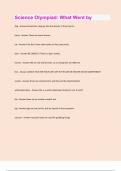Overig
Monetary and Fiscal Policy Solutions and Practice Exam with Solutions
- Instelling
- Universiteit Van Amsterdam (UvA)
Alle antwoorden van de opgaves tijdens werkcollege plus een oefententamen! De kans is heel erg groot dat het echte examen op dit oefententamen lijkt, want dat was in mijn jaar bij beide tentamens het geval! Veel vragen kwamen terug!
[Meer zien]













